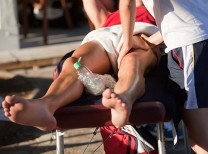Take a moment to appreciate how often we use our knees. We use them every day whether we’re playing our favorite sport, going up the stairs at home, or simply walking around our neighborhood. As we age, our bodies start feeling the wear and tear of our joints, known as osteoarthritis. It’s estimated that roughly 14 million Americans are suffering specifically from knee osteoarthritis.1 A major part of finding the right treatment plan is identifying the correct diagnosis. Fortunately, we live in an era of advanced technology and treatment options for people of all activity levels and all ages. There are plenty of non-surgical approaches to alleviate knee arthritis, ranging from heat/ice to an orthobiologics injection procedure.
Activity Modification
Activity modification and ice/heat are some of the most conservative approaches. A basic change in lifestyle goes a long way. Avoiding particular painful movements or decreasing the intensity of a workout can be therapeutic. Staying active is important though, so switching your workouts to low-impact exercises, for example water aerobics, can be beneficial as well. Ice or heat are other low-risk remedies, as they are natural healing modulators. Simple topical application can reduce swelling and pain.
Rehabilitation
Rehabilitation is one of the most widely accepted types of treatment for knee pain. This may mean doing home exercise plans, going to a physical therapist, or even seeing a personal trainer. Home exercise plans are a great starting point to take charge of your own recovery. However, patients may be more inclined to attend physical therapy because it’s more structured. Physical therapy is a set training program curated to strengthen the body and prevent injury. A licensed physical therapist will tailor the training plan to the patient’s injury, age and activity level. Other ancillary services they provide are soft tissue mobilization and ultrasound stimulation.
Bracing/Mobility Aids
Bracing and mobility aid options have come a long way in the past several decades. Today’s knee braces are designed to relieve pain, stabilize ligaments, and prevent further injury with high technology and advanced design. The patient can still be active while wearing a brace. Some companies offer custom bracing, where a representative will create a brace for the patient based on their individual sizing. Crutches are also a great choice to relieve the strain on the lower extremities and improve stability. Bracing and mobility aid options are often offered in orthopedic and sports medicine practices.
Medications
There are plenty of promising medications ranging from over-the-counter oral pills to topical gels to injectables. Acetaminophen (Tylenol) and non-steroidal anti-inflammatory drugs (NSAIDs) such as ibuprofen are helpful in controlling pain and reducing inflammation. There are also topical gels, such as diclofenac sodium (Voltaren), which is an NSAID that reduces inflammation directly on the problem area. Be sure to discuss the risks and precautions of any medication with your doctor before using it.
Injections
Injections come in a plethora of different “flavors,” including steroid, Hyaluronate (lubricating gels), prolotherapy and orthobiologics, such as cell therapy and even your own platelet rich plasma. A common type of injection is steroid which can be injected into almost every synovial joint in the body. Steroid injections reduce inflammation in the direct problem area, effectively alleviating pain and maintaining joint function. In-office ultrasound can provide a more precisely guided injection, leading to more successful outcomes.
Alternative Methods
Alternative therapies have dramatically expanded in the recent years, thanks to collective research and creativity of allied health care professionals. Some of these methods include, but are not limited to, acupuncture, cryotherapy, shockwave therapy, sports massages, supplements and chiropractic services. We hope more evidence-based literature is coming on these methods; however, they do show potential benefit with low risk for treating knee osteoarthritis.
Surgery
Sometimes, these less invasive methods do not work well for a patient and surgery is the best option. Conservative to aggressive treatments should be exhausted before opting for a surgical approach. Speak with your doctor about whether or not surgery is the right path for you.
Treatment plans are certainly not “one size fits all,” rather providers seek to find the best fit for the individual. The success of the patient’s treatment depends not only on which route a patient decides to take, but also on the cause of the pain. If you have knee arthritis, be sure to explore the many possibilities that are available today.
Dr. Sickinger is owner and physician at Advanced Center for Sports & Musculoskeletal Medicine. For more information, contact their Palm Desert office at (760) 636.1067 or the San Clemente office at (949) 388.1060, or visit www.SportsandMSKmedicine.com.
References:
1) Deshpande BR, Katz JN, Solomon DH, et al. Number of Persons With Symptomatic Knee Osteoarthritis in the US: Impact of Race and Ethnicity, Age, Sex, and Obesity. Arthritis Care Res (Hoboken). 2016;68(12):1743‐1750. doi:10.1002/acr.22897









































Comments (0)